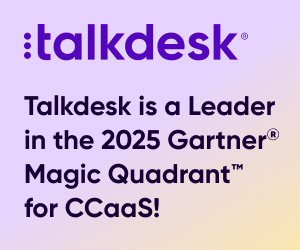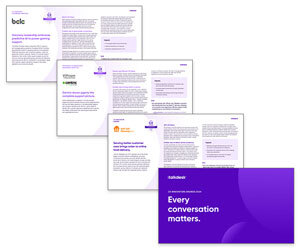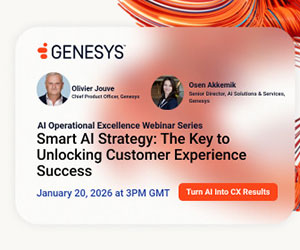Celia Cerdeira at Talkdesk discusses the essential management skills, tips, and strategies to help lead a high-performing contact centre and turn customer experience into a company’s superpower.
Contact centre management sits at the frontline of customer relationships, where every interaction is an opportunity to turn a good experience into lasting brand loyalty.
Delivering that level of service requires more than just answering calls, it demands a comprehensive customer experience (CX) strategy.
Businesses need to equip their contact centres with the right tools, hire and train skilled agents, and implement management practices that support responsiveness, empathy, and efficiency.
A successful strategy doesn’t happen by accident. Instead, it’s built intentionally through leadership, structure, and continuous improvement.
For organizations that want to make customer experience a competitive advantage, investing in contact centre management is not optional.
What Is Contact Centre Management?
Contact centre management is the practice of overseeing all aspects of a customer service hub where agents interact with customers.
It’s the responsibility of the contact centre manager to ensure operations run smoothly, from staffing and training to technology and customer satisfaction.
Depending on the size of the organization, managers might lead small, close-knit teams or oversee large, complex operations.
Some work with in-person teams in a shared office space, while others manage remote agents spread across different time zones. No matter the setup, most contact centre managers juggle a similar set of responsibilities, including:
- Managing Agents – Finding, training, and supporting the people who talk directly to customers.
- Managing Processes – Creating simple, effective ways to handle customer issues that don’t waste time or create confusion.
- Managing Technology – Picking user-friendly systems that help agents do their jobs without technical headaches.
- Managing Data – Using numbers and feedback to understand what’s working and what needs fixing.
- Managing Customers – Understanding what customers expect and how to make them feel valued and heard.
Contact centre management also means keeping a close eye on costs, whether it’s staffing, software, or training. Every investment should deliver measurable value.
When everything works together, the results are clear: happier customers, lower employee turnover, faster resolutions, and stronger business outcomes.
Agent Management – Make Every Agent Your Best Agent
Contact centre management starts with supporting the people who are closest to the customer – agents. These are the voices customers hear, the problem-solvers they rely on, and the frontline of every interaction.
It’s up to managers to empower agents with the tools, training, and guidance they need to do their jobs confidently.
Strong agent management goes beyond onboarding and equipment walkthroughs. Great training gives agents the skills to think proactively, handle challenges, and deliver exceptional service. Some elements of a smart training plan include:
- Real-world customer scenarios instead of generic scripts.
- Role-playing to prepare for difficult conversations.
- Clear, accessible guides for common issues.
- A mix of structured learning and hands-on experience.
- Ongoing coaching and feedback, not just one-and-done sessions.
- A team culture that encourages peer learning and knowledge sharing.
Even the best-prepared agents need the right tools. Modern contact centres rely on technology that supports performance. One of the biggest advances in this space is agent-assistive AI.
These tools can analyse conversations in real time and offer helpful prompts, suggested responses, or next steps – speeding up resolutions and reducing the need for transfers or hold time.
AI also takes care of repetitive tasks like writing up call summaries, often saving agents 30 to 60 seconds per interaction.
That adds up fast and gives agents more time to focus on what matters: helping customers. When agents have both strong training and supportive AI-powered technology, they’re set up for success from the start.
Process Management: Create a Smooth, Streamlined Customer Journey
In addition to supporting agents, one of the core responsibilities of a contact centre manager is overseeing the day-to-day processes that keep everything running. This includes scheduling, forecasting call volumes, and resolving unexpected issues as they arise.
At its heart, process management is about designing and coordinating the entire customer journey. Every touchpoint, from the first interaction to the final resolution, should feel connected and intuitive.
Managers play a key role in mapping out that journey, documenting how customers engage with the organization, and identifying ways to make each step more efficient and helpful.
That means diving into the details. Where do delays happen? Where do customers drop off? What feedback are they leaving behind?
By answering these questions, managers can refine workflows, eliminate friction, and ensure processes align with customer expectations.
When everything runs smoothly behind the scenes, customers feel the difference, leading to better satisfaction, improved loyalty, and fewer repeat issues.
Technology Management – Put Time-Saving AI to Work
The right technology can speed up service, reduce mistakes, and boost customer satisfaction. Simple automation handles background tasks, while AI virtual agents take care of routine inquiries.
Key technologies that drive modern contact centres include:
Artificial Intelligence
AI transforms contact centre operations by enabling self-service options for customers and providing real-time assistance to agents during calls, helping them solve problems faster.
Interaction Analytics
These tools monitor and analyse customer conversations in real time and store them for later, including sentiment analysis that reveals how customers truly feel about their experiences with an organization.
CRM Integrations
Connecting communication tools with customer data systems gives agents a complete view of the customer journey.
With everything in one place, agents can resolve issues more efficiently without toggling between platforms.
Intelligent Call Routing
This system matches customers with agents who are best equipped to handle their specific needs. It boosts first contact resolution and reduces customer frustration by getting them to the right person faster.
With the right tech in place, contact centre managers can manage customer data more effectively and learn from every interaction.
Data Management – Learn From Actionable Customer Insights
In contact centres, data management means systematically gathering, organizing, and interpreting customer interaction information to improve overall service.
Contact centre managers are often involved across all stages of data analysis, from analysis of raw data to changing internal processes based on interpretations of the stats.
Some of the datasets a manager might use to drive efficiencies include:
- Speech analytics – This technology automatically analyses voice conversations to identify trends, compliance issues, and training opportunities without requiring managers to listen to every call manually.
- Customer experience analytics – These metrics track the full customer journey across all touchpoints, revealing where experiences excel or fall short across different channels and interaction types.
- Customer feedback – Direct input from customers through surveys, ratings, and comments provides crucial insights about satisfaction levels and specific areas needing improvement.
Data management also involves clear reporting for stakeholders throughout the organization. Contact centre leaders need to translate complex data into understandable formats for executives and team members.
The ideal solution for leading organizations is a real-time data dashboard that displays the most important metrics at a glance, allowing anyone to understand performance trends and make informed decisions.
What Does a Contact Centre Manager Do?
A contact centre manager plays a critical role in supporting agents and improving the customer experience. Their job involves overseeing day-to-day operations while also being responsible for creating an environment where agents can do their best work and customers feel valued at every touchpoint.
To succeed in this role, a manager should bring a blend of practical experience and personal strengths, including:
- An understanding of customer service – A manager should be a seasoned customer service expert. They’ll need to mentor junior staff, passing on useful knowledge and skills. They may also be required to step in on handling frustrated customers or complex problems.
- Emotional intelligence – Keeping a clear head in stressful situations and having a positive attitude go a long way in fostering a supportive, successful working environment.
- Strong communication skills – Clear communication is essential in a contact centre environment. A strong manager needs to relay information, directions, and feedback to the agents.
- A problem-solving mindset – Finding proactive solutions to problems as they arise is part of the daily duties of a manager in a fast-paced contact centre environment.
How to Manage a Contact Centre in Six Steps
Managing a contact centre isn’t a one-person job or a single task. It requires coordination, teamwork, and ongoing evaluation to make sure customers have the best experience possible.
Consider these six helpful steps to managing a successful contact centre:
1. Analyse the Current State of Your Contact Centre
The first step for contact centre managers is conducting a thorough audit of existing operations. This evaluation identifies areas of strength and weaknesses.
An audit can surface how a contact centre is providing value to both customers and the organization and areas that are not cost-effective.
The assessment should examine all potential success metrics, including customer experience KPIs, agent satisfaction, security compliance, and the current technology infrastructure.
2. Create a Cohesive Contact Centre Improvement Strategy
Managers should then develop a detailed improvement plan. Analyse the audit results to better understand where and how the current business operation needs to be improved.
Check out these suggestions on how to improve contact centre operations:
- Optimize contact centre staffing – Ensure the right number of agents are available at the right times based on predicted call volumes and customer needs.
- Evaluate human agent performance – Regularly review agent interactions for performance and quality to identify areas for improvement and recognize strengths.
- Train AI agents to handle tasks autonomously – Use virtual agents to manage routine inquiries and processes.
- Route customers to the best solutions – Use technology solutions to direct customers to the most appropriate resource or agent based on their specific needs and the nature of their inquiry.
- Consider employee reward programs – Create recognition systems that improve agent job satisfaction and reduce turnover by acknowledging excellent performance.
3. Invest in the Right Contact Centre Technology
The right technology can improve a contact centre’s performance. Invest in solutions that align with business objectives, support agents, and help reduce overall costs.
The best contact centre technology should:
- Provide AI-powered assistance during customer interactions.
- Offer comprehensive analytics capabilities.
- Enable seamless integration with existing systems.
- Support multiple communication channels.
- Feature intuitive interfaces that reduce training time and provide agents with all the information they need.
- Be easily scalable to differently sized teams and remote environments
4. Support an Omnichannel Contact Strategy
Customer communications don’t stick to one platform. Instead, they move between channels. Today, customers expect to engage across different channels and move effortlessly between them.
An omnichannel contact centre connects all customer communication channels, phone, email, chat, social media, and more, into a unified system that keeps interaction context.
This model represents a significant upgrade over traditional systems by enabling seamless customer journeys while giving agents access to complete, contextual history.
Agents can pick up customer conversations from other channels, even from other agents, all without customers needing to repeat themselves.
5. Set Customer Experience Goals, and Make Sure Everyone Understands Them
Strong contact centre management starts with setting clear, measurable goals that align with the organization’s long-term strategy.
These goals give the entire team a shared direction and help focus efforts on what matters most – improving the customer experience in ways that create real impact.
Some common customer experience goals include:
- Reducing average handle time (AHT).
- Improving first contact resolution (FCR) rates.
- Increasing customer satisfaction scores (CSAT).
- Lowering customer effort scores (CES).
- Improving service level.
Gathering this information might be a goal in itself. Make it easy for customers to provide regular feedback, like short surveys, and analyse this data for common pain points, sticking points, or other issues that can be turned into more effective solutions.
6. Provide Agents With the Training They Need
Ongoing training is essential for keeping contact centre agents sharp, confident, and adaptable. As products, services, and technologies evolve, regular refresher sessions help agents stay up to date.
This includes updates on new features, common customer issues, and best practices for using evolving tools like AI-powered support platforms.
In addition to technical skills, ongoing training should focus on communication and emotional intelligence. Role-playing exercises and real-world scenarios help agents practice active listening, de-escalation techniques, and adapting to different customer personalities.
Plus, teaching agents how to manage their own emotions during high-stress interactions leads to more constructive conversations and better outcomes.
When continuous learning is built into the culture, teams stay aligned, engaged, and better equipped to meet customer needs.
7. Monitor Contact Centre Processes Over Time
Contact centre call monitoring gives managers valuable insight into how agents work, what they’re doing well, where they need support, and how they handle real conversations.
It’s an opportunity to provide regular, constructive feedback and spot patterns, like when agents go off-script in ways that actually improve outcomes or when they’re struggling with similar types of interactions.
By understanding how agents navigate customer interactions, managers can refine scripts and processes to create more consistent, reliable experiences for customers.
Contact centre monitoring also helps surface training needs. If multiple team members are hitting the same roadblocks, it’s a clear sign that targeted coaching or group sessions can make a big impact.
To get the most out of quality assurance monitoring, consider these key practices:
- Reviewing a variety of interactions across different times and channels to get a well-rounded view of performance.
- Tracking key performance indicators (KPIs) to pinpoint strengths and spot areas for improvement.
- Conducting regular reviews to ensure compliance with regulations and internal service standards.
- Holding manager check-ins to stay aligned on quality benchmarks and coaching approaches.
- Offering self-assessment opportunities that encourage agents to reflect and build critical thinking skills.
- Creating space for team feedback and discussion to promote shared learning and continuous improvement.
Contact Centre Management Best Practices for Better Results
After outlining what long-term success looks like, a contact centre manager can improve results by following these best practices.
Pair New Agents With Experienced Mentors
Mentorship programs help new hires feel supported from day one. Assigning seasoned agents as go-to resources fosters teamwork, knowledge-sharing, and a stronger overall culture.
Use Workforce Management Tools for Smarter Scheduling
Advanced scheduling tools can forecast demand and help balance agent coverage more effectively. These systems should factor in events like seasonal spikes, product launches, or campaign surges to minimize gaps in service.
Leverage Dashboards for Real-Time Visibility
Equip agents with customer-facing dashboards that show key metrics in real time. Visibility into queue times, resolution rates, or team performance helps everyone stay aligned and responsive.
What Are Some of the Main Challenges to Effective Contact Centre Management?
Even the most well-prepared contact centre manager can still face challenges in the workplace. Here are some common roadblocks:
High Agent Turnover Rates Increase Training Costs and Reduce Service Quality
A constant cycle of recruitment and training can lead to knowledge gaps or poor service as new hires get up to speed.
Evolving Customer Expectations Create Continuous Change
Preferences for communication channels and service styles can vary widely. Contact centres need to stay attuned to where, when, and how customers want to engage and adjust accordingly.
Balancing Efficiency Metrics With Quality of Service Creates Challenges in Performance
Emphasizing speed too heavily may encourage agents to rush through calls, leading to incomplete resolutions or customer dissatisfaction. Striking the right balance is essential for sustainable success.
Managing Unpredictable Contact Volumes During Peak Periods Tests Even the Most Well-Designed Staffing Models
Spikes caused by product issues, outages, or viral moments can overwhelm teams and impact service levels. Flexible contingency plans are crucial for staying on top of demand.
Maintaining Consistent Performance Across Multiple Communication Channels Becomes Increasingly Difficult With Scale
Agents may be more comfortable on some channels than others, leading to inconsistent customer experiences. Clear guidelines and cross-channel training help ensure quality standards, no matter the platform.
Integrating New Technologies While Maintaining Operations Presents Change Management Challenges
While new tools can offer long-term benefits, they often disrupt workflows in the short term. Effective planning, communication, and phased rollouts are key to minimizing resistance and ensuring smooth adoption.
With the right strategies and tools, contact centres can mitigate many of these challenges. Doing so requires planning and continuous learning, but the results are worth it: an adaptable, effective contact centre that delivers value for its customers.
This blog post has been re-published by kind permission of Talkdesk – View the Original Article
For more information about Talkdesk - visit the Talkdesk Website
Call Centre Helper is not responsible for the content of these guest blog posts. The opinions expressed in this article are those of the author, and do not necessarily reflect those of Call Centre Helper.
Author: Talkdesk
Reviewed by: Rachael Trickey
Published On: 15th Jul 2025
Read more about - Guest Blogs, Celia Cerdeira, Talkdesk






 Talkdesk is a global customer experience leader for customer-obsessed companies. Our contact center solution provides a better way for businesses and customers to engage with one another.
Talkdesk is a global customer experience leader for customer-obsessed companies. Our contact center solution provides a better way for businesses and customers to engage with one another. 


































